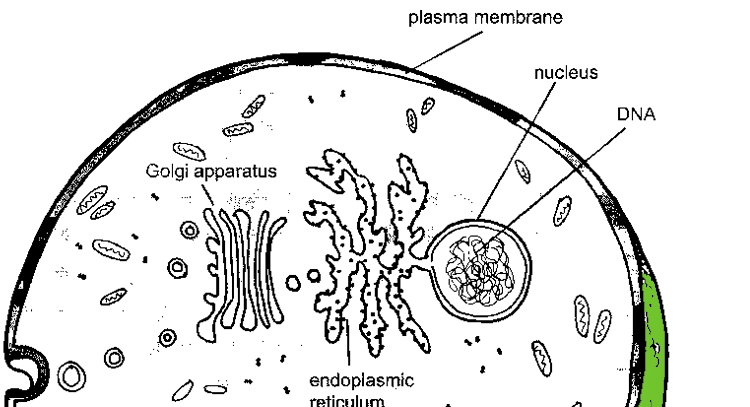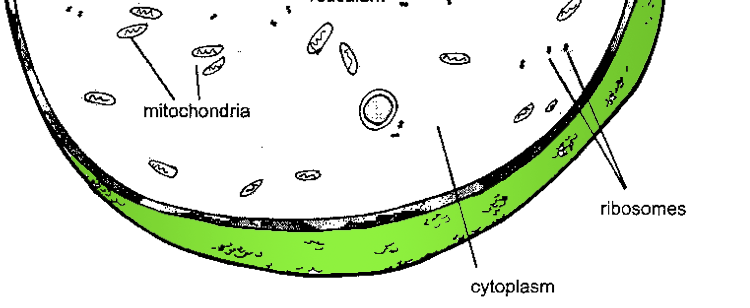














































An organism’s DNA contains all of the information required to build its anatomical features and run its physiological processes. But how is that information accessed and used? How does a molecule of DNA exert its influence on the body? At a very basic level, DNA contains the recipes to make proteins. The process of making these proteins follows a very specific set of steps.
DNA (short for deoxyribonucleic acid) is a double-stranded molecule made of nucleic acids that is found in a small chamber inside an organism’s cells called the nucleus (Fig. 5.1). Each DNA strand contains many regions known as genes. These genes are the recipes used to make specific proteins. The kitchen where these proteins are made is outside the nucleus in the cell’s internal fluid (called the cytoplasm) and the cooks are small, protein building organelles called ribosomes. Now, when you or I use a recipe, we take it into the kitchen where we’ll do the cooking. In the cell, however, we are not allowed to take the DNA recipes out of the nucleus and into the cytoplasmic kitchen. To get the recipes to where we make the proteins, the recipes must be copied and transported out of the nucleus.
Making a protein starts when the double-stranded DNA recipe is used as a template to make a singlestranded molecule of RNA (ribonucleic acid) This RNA is our copy of the DNA recipe for a protein and can leave the nucleus. Since the information in DNA and RNA is written in the same nucleic acid language, the process of making RNA from DNA is know as transcription (Fig. 5.2).


Figure 5.1 The animal cell is composed primarily of watery cytoplasm contained in a lipid plasma membrane. The genetic material (DNA) is contained in the membrane-bound nucleus.
Once transcribed, the RNA can move from the nucleus to the cytoplasm (the kitchen), where it is received by the ribosomes (the cooks). The ribosomes must now take the RNA recipe and build a protein molecule. However, proteins are not built of nucleic acids. They are composed of units known as amino acids. Thus, the ribosomes must read the nucleic acid recipe and translate it into amino acid ingredients. This process of making proteins using RNA recipes is called translation (Fig 5.2).
This entire operation, which can be summarized as DNA to RNA to protein, is known as the Central Dogma of biology (Fig. 5.2). Of course, the process is a touch more complicated. Sometimes the protein needs to be tweaked before and after the translation process. These alterations, known as pre-and post-translational modifications, can include adding molecules to the protein that further refine the specificity of its function.

Organisms are constructed and run by the proteins encoded by their DNA. But is the Central Dogma all we need to understand about how a complex plant or animal is built? Not really. In between the DNA code for an animal and the animal itself is a long, complicated process known as development. During development, a single fertilized egg gives rise to billions of well-organized, specialized cells found in tissues (like muscles and bones), as well as to larger anatomical features such as eyes and appendages.
Just as building a house often requires several construction workers, it takes a multitude of genes to build an organism (25,000 for human, 13,700 for a fruit fly) and the activity of those genes, like the activity of construction workers, must be coordinated. If you tried to run the electricity for a house before the foundation was laid, the end result probably wouldn’t be livable. Likewise, building an organism requires more than just pumping out a bunch of proteins. The production of these proteins must be coordinated so that they are only produced at the appropriate time and place. This coordination is carried out in the cell by regulatory genes. One interesting class of regulatory genes are the homeobox genes (or hox genes, for short).
Hox genes are sometimes referred to as “master” genes and several have been identified in the animal kingdom. Perhaps the most fascinating thing about hox genes is that they are nearly the same in most critters. Despite significant differences in how eagles and bees look, the same hox genes seem to play the same general roles in directing the construction of specific structures (Fig. 5.3). A relevant example is the pax-6 gene. Pax-6 has been identified in nearly all animal species ranging from jellyfish to humans. In each case, it appears to play a role in directing the formation of the animal’s eyes, whether it is the camera eyes of a jellyfish or the compound eyes of a dung beetle.
Of course, a lot can go wrong during the transition from a fertilized egg to a fully formed organism. This is why development is of so much interest to evolutionary biologists. It appears that most animals utilize the same basic tool kit of hox genes, but slight genotypic variations in how those hox genes function early in development can have significant effects downstream on the phenotype. To visualize how this might happen, imagine you are an archer and you shoot an arrow 100 feet. If you shift your aim by just one inch, your next shot will land almost three feet away from the first one. A mutation in a hox gene (called a homeotic mutation) can result in regulatory changes that alter the fate of an entire structure. Mutations in the fruit fly hox gene antennapedia, for example, can cause legs to grow where antenna should be and vice versa.
Odysseus Gets Sheepish Polyphemus was the Cyclops encountered by Odysseus in
Homer’s epic poem The Odyssey. In that tale, Polyphemus caught
Odysseus and his crew trespassing in his cave, trapped the interlopers
and ate six of them. To escape, Odysseus and his men stabbed
Polyphemus’ eye out with a big, pointy stick. With Polyphemus
blinded, our heros slipped past him when he opened the cave to
put his flock out to pasture. Though Polyphemus felt the back of
each animal for riders, he missed Odysseus and his men, who had
strapped themselves to the bellies of Polyphemus’ sheep. |
Figure 5.2 The Central Dogma of Biology. Information on a DNA molecule is transcribed into a molecule of RNA. The RNA then leaves the nucleus and enters the cytoplasm. In the cytoplasm, the information in the RNA molecule is translated into a protein by an organelle called a ribosome. |
|
The connection between sheep and the Cyclops isn’t just mythological. It’s developmental. In 1968, researchers described a phenomenon in which baby sheep were stillborn with a single central eye. Clearly something had interfered with their development, but what was it? The culprit turned out to be a chemical found in the lily Veratrum californicum called cyclopomine. When a pregnant ewe grazed on this lily during a critical time in her offspring’s development, the cyclopomine blocked the activity of a gene known as Sonic hedgehog (Shh). The protein product of Shh diffuses between neighboring cells and stimulates the organization of tissues of the head into neat left and right sides. When Shh activity is blocked during development, developing eyes fail to separate and cyclopic sheep are bom. No Chemicals AddedIn blind cave fishes, eye development is inhibited and no eye forms. However, unlike the sheep described above, the alteration of eye development in blind cave fishes is not due to some outside chemical agent; instead, it appears to be the result of selection for a mutation of a gene called hedgehog (not to be mistaken for Sonic hedgehog). The mutant version of hedgehog in these fishes interferes with pax-6, the hox gene that directs eye development. This interference blocks the development of eyes and promotes stronger jaws and more taste receptors. This mechanism for the loss of eyes in cave fishes is significant because it dispels the notion that eyes are lost because of disuse. Though often invoked, disuse was never a compelling explanation for the loss of eyes in cave animals because there is no gene for “disuse" that could be selected for in nature. By contrast, the hedgehog mutation in blind cave fishes could be selected for strongly.
|
|
Oh, Sure, Eyes are Great, BUT...As wonderful as eyes are, they do have their down side. As we mentioned in Chapter 3, in order to let light into the eye, the body has to form a thin spot in it’s protective outer layer. As such. the eyes are a relative easy avenue into the body for bacteria, viruses and parasites. They are also weak spots that are often exploited by predators. On top of all of that, eyes are metabolically expensive to make and maintain. Sheesh. Why bother with them in the first place? The answer is that the benefits of vision usually outweigh the costs. In evolutionary terms, there is a trade-off between the adaptive value eyes provide and the less than desirable costs. But blind cave fishes don’t get any visual benefit from their eyes, so they are only left writh the costs. In a case like this, the mutation in hedgehog that inhibits eye development would provide an obvious adaptive value for cave fishes that had it. And the case for selection is made even stronger when we consider that they exchange eyes for something that could come in quite handy in the dark (stronger jaws and more sensitive taste reception).  He Would Have Missed AnywayAfter they escaped the cyclops’ cave, Odysseus and his men hightailed it to their ship. But, once they were safely aboard and rowing away, Odysseus’ cockiness got the better of his common sense and he decided to taunt Polyphemus. The enraged Polyphemus blindly charged toward the shore and started chucking boulders at Odysseus’ ship. There were a few near misses, but in the end Odysseus and his crew managed to get away. The fact that the blinded Polyphemus almost hit Odysseus’ ship might make you think that he could have clobbered Odysseus and his men if only he’d had his eye. Maybe, but probably not. You need depth perception to hit a target at a distance and depth perception requires binocular vision. Binocular vision is the product of two closely-spaced eyes on the front of the face that provide slightly different pictures of the world. What your right eye sees is shifted a touch to the right relative to the picture seen by your left eye. Your brain uses these two different images to gauge how far away something is and uses that information to calculate how hard to throw something (a boulder, for example). So, Polyphemus probably wouldn’t have been very good at hitting the mark even before he got a big pointy stick in his eye. |
|